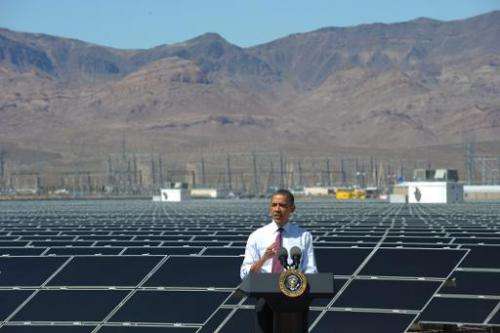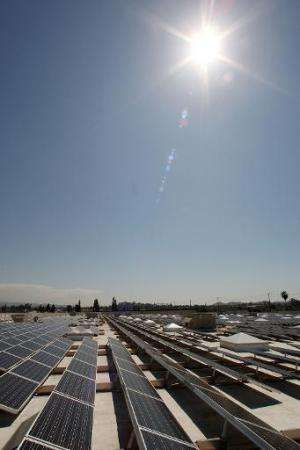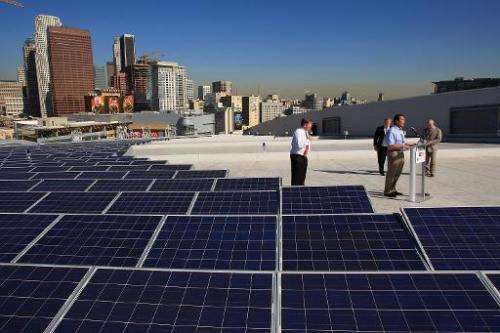US solar power sector small but growing

Solar power, only a minuscule part of the energy mix in the United States, is getting a boost from cheap panels, growing acceptance by large companies and chances for homeowners to rent solar systems.
Analysts expect a phenomenal growth for renewable solar power over the next two decades, after huge gains in the past two years: 60 percent growth in 2012 and 30 percent on top of that this year.
Heavily reliant on oil, natural gas, coal and nuclear, the United States only gets 12 percent of its power from renewables, of which solar is the smallest part, less than one percent.
But the sector is expanding faster than any. There's no question, says Charles Ebinger of the Brookings Institution, that solar energy "will continue to grow quite dramatically."
The US Energy Information Administration predicts that photovoltaics—the semiconductor technology that converts sunlight into electricity—will grow 11.6 percent a year through 2040.
On top of that, it also predicts 3.6 percent annual growth for solar thermal energy, which uses vapor from water heated by the sun to drive turbines.
By comparison, wind power is expected to grow at two percent a year and geothermal power at four percent a year.
Ebinger attributes solar power's fast growth to a decrease in the price of photovoltaic panels in a generously oversupplied market, making the energy source more competitive with other types of renewable energy.
Additionally, the possibility for homeowners to simply rent panels rather than purchasing them has helped their popularity.
Around 55 percent of US demand for solar panels currently comes from power generating companies.
Another 30 percent comes from businesses that have large buildings and massive rooftops where installing solar systems for their own power makes sense.

This includes companies like retail giant Walmart, and Google, which puts the panels on top of its huge data centers.
The rest of demand comes from the residential sector.
Network links, battery storage still big challenges
Large obstacles still dot the road forward for US solar energy.
Ebinger said connecting solar power to existing electricity distribution networks requires substantial investment.
Solar power parks, built with thousands of panels in a single location to generate power, are often located in sparsely populated areas such as the deserts of the American southwest, far from industrial centers and household consumers.
Storage is another problem, because batteries remain expensive and very large.
SolarCity, the leading builder of solar electricity systems, is partnering with electric-car maker Tesla Motors to improve solar power storage, especially for private homes. Tesla's founder and chief executive, inventor Elon Musk, is chairman of SolarCity.
Storage is the key challenge.

"You can rely around the clock on hydrocarbons, nuclear or even hydroelectricity," said Morningstar analyst Stephen Simko. But "with solar, when there is no sun there is no power."
Even if the threat of global warming makes using alternative energies more crucial, Simko said, on a purely economic basis, hydrocarbons are much cheaper and more profitable to work with.
"There is the issue of climate change, but if we are still talking about economics," he said, solar "is much more expensive and capital-intensive."
That is why governments need to continue supporting the sector, said Simko.
"The entire solar market in the US and rest of the world is based on tax credits and subsidies."
California is the largest producer of solar energy thanks to supportive legislation and favorable tax set-ups, followed by Arizona and New Jersey.
Angelo Zino, an analyst with S&P Capital IQ, expects that by the 2020s, solar power will account for five percent of the electricity generated in the United States.
And Ebinger estimates that solar's growth could drive renewables to 20 percent of the entire energy market by 2030-2035.
© 2013 AFP




















